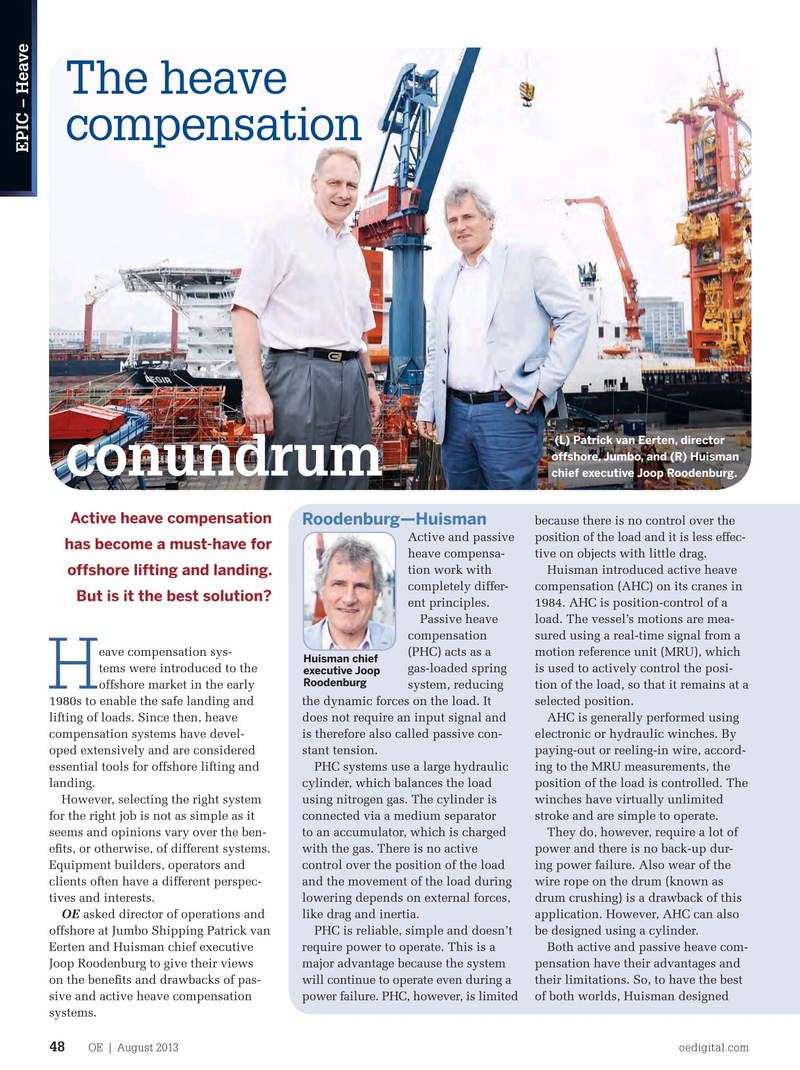
Page 46: of Offshore Engineer Magazine (Aug/Sep 2013)
Read this page in Pdf, Flash or Html5 edition of Aug/Sep 2013 Offshore Engineer Magazine
The heave compensation
EPIC – Heave (L) Patrick van Eerten, director offshore, Jumbo, and (R) Huisman conundrum chief executive Joop Roodenburg.
Active heave compensation because there is no control over the
Roodenburg—Huisman
Active and passive position of the load and it is less effec- has become a must-have for heave compensa- tive on objects with little drag.
tion work with Huisman introduced active heave offshore lifting and landing. completely differ- compensation (AHC) on its cranes in
But is it the best solution? ent principles. 1984. AHC is position-control of a
Passive heave load. The vessel’s motions are mea- compensation sured using a real-time signal from a eave compensation sys- (PHC) acts as a motion reference unit (MRU), which
Huisman chief tems were introduced to the gas-loaded spring is used to actively control the posi- executive Joop
Roodenburg offshore market in the early system, reducing tion of the load, so that it remains at a
H 1980s to enable the safe landing and the dynamic forces on the load. It selected position.
lifting of loads. Since then, heave does not require an input signal and AHC is generally performed using compensation systems have devel- is therefore also called passive con- electronic or hydraulic winches. By oped extensively and are considered stant tension. paying-out or reeling-in wire, accord- essential tools for offshore lifting and PHC systems use a large hydraulic ing to the MRU measurements, the landing. cylinder, which balances the load position of the load is controlled. The
However, selecting the right system using nitrogen gas. The cylinder is winches have virtually unlimited for the right job is not as simple as it connected via a medium separator stroke and are simple to operate. seems and opinions vary over the ben- to an accumulator, which is charged They do, however, require a lot of efts, or otherwise, of different systems. with the gas. There is no active power and there is no back-up dur-
Equipment builders, operators and control over the position of the load ing power failure. Also wear of the clients often have a different perspec- and the movement of the load during wire rope on the drum (known as tives and interests. lowering depends on external forces, drum crushing) is a drawback of this
OE asked director of operations and like drag and inertia. application. However, AHC can also offshore at Jumbo Shipping Patrick van PHC is reliable, simple and doesn’t be designed using a cylinder.
Eerten and Huisman chief executive require power to operate. This is a Both active and passive heave com-
Joop Roodenburg to give their views major advantage because the system pensation have their advantages and on the benefts and drawbacks of pas- their limitations. So, to have the best will continue to operate even during a sive and active heave compensation of both worlds, Huisman designed power failure. PHC, however, is limited systems.
OE | August 2013 oedigital.com 48 048_OE0813_EPIC1_Heave.indd 48 7/22/13 12:36 AM

 45
45

 47
47